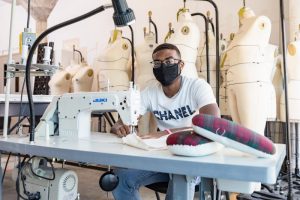From wearable items to peer advising, senior fashions creative ways to express himself and help others.

In developing his brand, “The Kollection,” over the past 10 years, Kendell Wiley ’21 has refined his fashion concepts as a form of self-expression. This winter, Wiley is executing his final project as a fashion design major in Syracuse University’s College of Visual and Performing Arts, and he finds other ways to express himself as well. Serving as a campus leader and peer advisor, he helps others shine.
As an adolescent in a suburb of Atlanta, Georgia, coping with the separation of his parents, Wiley drew simple figures, using words and phrases to illustrate his feelings. “I didn’t consider myself an artist, but there were things I was feeling and didn’t know how to say, so I found a way to express them,” he says. Soon after, Wiley discovered that he could give his expressions a wider audience and, at the same time, help a friend. He started putting his messages onto everyday shirts and sweatshirts. “I would transfer my work onto a hoodie or something they could wear,” he says. During high school, Wiley learned to use Photoshop to manipulate his graphics, and he also experimented with tactile methods like embroidery to better articulate his themes.
The discovery that he could apply creative expression to a practical, wearable medium instilled the fashion bug in Wiley. A Posse Scholarship semifinalist in high school, he started considering colleges where he could study fashion and found himself focused on schools up north. He chose Syracuse University when the Student Support Services program helped make it possible for him to fulfill his dream of studying beyond his home state. “I’m often asked why I’m so far from home,” says Wiley. “I wanted to travel while I had the opportunity. I wanted to see what else is out there in the world.”
Sewing and Sharing
In the University’s undergraduate fashion design program, students design, create and develop fashion products from concept through completion. In the early stages of this process, they put their ideas on paper. Then they learn to translate them through pattern-making into 3D forms and, finally, into finished designs. Coming into the program, Wiley didn’t know how to sew. The learning curve seemed steep, but the possibilities were inspiring.
“The execution and the construction were the means and the medium to give form to all my ideas,” Wiley says. The construction materials and the development of technical skills—from selecting fabric to constructing zippers, darts, waistbands and interfacing—offered boundless new forms of expression. His first product was a baby blue pencil skirt. Feeling satisfied with this first-year assignment, he took it home at winter break and gave it to a friend.
As Wiley learned to sew and master the construction aspect of fashion design, he was adjusting to a new place, too. “When I first arrived at Syracuse, it was a culture shock for me, being hundreds of miles from home,” he says. “Everything was different: the style, form of communication, people, food.” Then he discovered the Syracuse chapter of Kappa Alpha Psi Fraternity. One of the nine historically Black international Greek organizations that make up the National Pan-Hellenic Council (NPHC), Kappa Alpha Psi is focused on community service, social welfare and academic scholarship.
In addition to serving as vice president of the fraternity’s Delta Beta chapter at Syracuse, Wiley is academic chair with the NPHC. “I’m helping to make sure my NPHC colleagues are succeeding in their academics,” he explains. He keeps council members updated on academic topics and makes them aware of resources that can help them achieve success. “The fraternity has helped me find my way through college,” he says. “It has helped me become the person I’ve always seen myself being.”
This year, Wiley expands the reach of his positive impact by promoting health and wellness with Peer Educators Encouraging Healthy Relationships and Sexuality (PEEHRS). Peer educators are role models and liaisons who connect students to health and wellness resources on and off campus in three areas: substance use, sexuality and relationships, and mental health. For example, in a recent seminar, participants learned about the bystander effect and how to overcome barriers to intervening in situations that might be dangerous, risky or unsafe to another person. “As part of this team, I’ve learned and shared a lot about sexual health and education, the importance of boundaries and communication in relationships and situations, and much more,” he says. For Wiley, PEEHRS is another way to open his eyes to the world around him and help others by sharing information.
The Finishing Touches
As Wiley prepares his senior collection in the design studio, his work is coming full circle. Incorporating graphics and messages into a series of wearable items for women, his final project features the themes of Black Lives Matter with words and strong graphic elements. He’s also trying out methods like applique, harkening back to his beginnings in print and embroidery. Over the course of the bachelor of fine arts program, each year has culminated in a final assignment to create specific types of clothing items and outfits. “The senior project represents so much that I have learned, but I knew for sure that I wanted to do something based on my beginning with graphics,” Wiley says.
After graduation, Wiley plans to return to the Atlanta area to pursue a career in fashion. When asked which fashion world professionals he admires, Wiley’s examples are diverse: Phil Knight, co-founder and chairman emeritus of Nike and a renowned American billionaire; Yves Saint Laurent for “the style and elegance he brings to fashion”; Jeremy Scott for his use of color; and designers Pharrell Williams and Mohammad Diallo for the fun they have with their work. “Parts may not seem like fun during the actual creation process,” he says, “but once everything is all said and done, it’s like a new beginning.”
